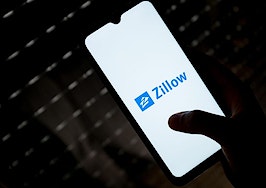In these times, double down — on your skills, on your knowledge, on you. Join us Aug. 8-10 at Inman Connect Las Vegas to lean into the shift and learn from the best. Get your ticket now for the best price.
A sluggish housing market and lukewarm economy appear to have dinged portal giant Zillow this year, with the company’s latest earnings report revealing that between January and March revenue sank while losses rose.
The report, out Wednesday, shows that in the first quarter of 2022 Zillow brought in $469 million in revenue. That’s down 13 percent from the $536 million Zillow brought in during the first quarter of 2022 — a period that notably preceded the rate hikes and sales slowdowns that came to dominate last year.
Zillow also lost $22 million between January and March. That’s a reversal from the net profit of $16 million that the company earned in the first quarter of 2022. On the other hand, the loss was an improvement over the final three months of 2022, when Zillow burned through $72 million.
Broken down by segment, Zillow’s mortgage business took the biggest hit, with revenue falling 43 percent year over year in the first quarter of 2023. Revenue from Zillow’s residential segment — which includes the Premier Agent lead generation program for real estate professionals — fell 14 percent, to $361 million.
The drop in residential revenue was “driven primarily by lower Premier Agent revenue as a result of weakness in the overall housing market,” the report goes on to explain. Despite the dip in revenue, however, Zillow actually expected Premier Agent revenue to fall as much as 28 percent — meaning the company outperformed its own expectations, the report notes.
Either way, a first-quarter highlight for Zillow was its rental business, which saw revenue increase 21 percent compared to the same period a year earlier. The report notes that Zillow continues to “see strong traffic and growth in multifamily properties.”

Rich Barton
Despite the falling revenue and rising losses, Zillow CEO Rich Barton struck an optimistic tone in the report, saying that “we’re starting to see our investments pay off, with first-quarter financial results that outperformed the top end of our outlook.”
“We’re capturing more customer demand and connecting more of that demand to our strengthening partner network, and these numerous incremental improvements have added up to make a real impact on our business,” Barton continued. “Our powerful brand and strong balance sheet put us on solid footing as we build the housing super app and help get more and more people home.”
In a statement, the company also said that “2023 is critical for Zillow,” and that it is focused on building its “super app.” Barton reiterated that point during a call with investors Wednesday afternoon, adding that “we continue to live in a very challenging macro housing environment with no indications of a turn.”
“While we may see rates come down at any time,” he added, “we are certainly not counting on it.”
Heading into Wednesday’s earnings, Zillow shares were trading in the low $40 range. That was down slightly for the day and week, but up nearly $10 compared to six months ago.
Zillow shares surged in after-hours trading immediately following the publication of the company’s earnings report.

Credit: Google
Zillow had a market cap of about $9.9 billion as of Tuesday afternoon.
The company last reported earnings in February, at which time it revealed that it brought in $435 million in revenue during the fourth quarter of last year. That figure represented a drop of 19 percent compared to one year earlier. It’s also less than Zillow made during the first quarter of this year.
The company also suffered a net loss of $72 million in the fourth quarter of 2022. While an objectively large number, that loss was actually way down from the $261 million Zillow lost in the fourth quarter of 2021 — a period when the company was working to exit the iBuying sector.
For all of 2022, Zillow brought in about $2 billion in revenue, an 8 percent year-over-year dip, and lost $101 million, which is down from $528 million during the prior year.
In addition to financial numbers, Zillow’s new earnings report reveals that the company had 212 million average monthly unique users to its websites and mobile apps. That number is flat compared to the same time one year earlier, the report reads.
Overall visits to Zillow’s sites total 2.5 billion between January and March, which represents a 5 percent year-over-year drop.
During his call with investors, Barton spent significant time outlining Zillow’s path forward. Among other news, he noted that the company is having success offering on-demand home tours via ShowingTime, and that people who request a tour convert to actual real estate consumers at higher rates.
“Real-time touring is improving our funnel,” Barton said on the call.
Barton also discussed Zillow’s efforts to beef up its mortgage business. He noted that most consumers finance their home purchases with a loan, that many also begin their homebuying journey by searching for a mortgage, and that many such individuals don’t start off with an agent. Zillow consequently sees opportunities both in connecting consumers to agents and in providing mortgages.
“We think there is a big prize for us in purchase mortgage originations,” Barton said, noting at another point that Zillow has taken steps such as including mortgage features in its app.
Earlier in the call, Barton also touched on the proliferation of artificial intelligence. Zillow announced a plugin for ChatGPT this week, and Barton said Wednesday that he thinks the rise of such AI tools could be as impactful as the first graphical interfaces for computers — think Windows — or the first touch interfaces that arrived with smartphones.
Barton ultimately touted Zillow’s past investments with AI, which include everything from the Zestimate to “AI-generated immersive floor plans.” And he argued that AI should ultimately improve the customer experience and improve employee efficiency, among other things.
“We are excited and confident,” he added, “to harness this power to drive growth.”
Update: This story was updated after publication with additional information from Zillow’s earnings report, and with comments from the company’s investor call.













